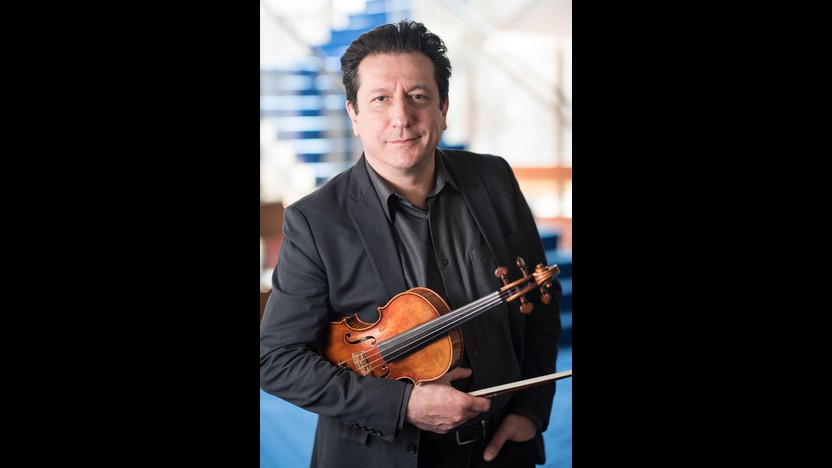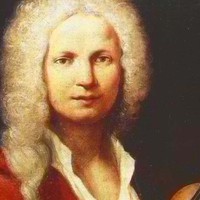Vivaldi's Four Seasons

Sponsored By
- November 23, 2012

- November 24, 2012


Sponsored By


Marco Enrico Bossi, the son of an organist, left the Milan Conservatory in 1881 to take up an organist position in the northern town of Como. In the following decades, he reshaped organ pedagogy across Italy as he progressed through a series of teaching positions in Naples, Venice, Bologna, and Rome. As a composer, he is best known for his organ music, but he also contributed enduring choral and instrumental works.
Bossi’s Intermezzi Goldoniani references Carlo Goldoni, an eighteenth-century Venetian librettist known for his comic operas. Bossi crafted his six intermezzi as a stylized dance suite, another nod to older times. This score for string orchestra, composed in 1905, predates by more than a decade the nostalgic, neoclassical trend that emerged in such works as Ravel’s Le tombeau de Couperin and Stravinsky’s Pergolesi-inspired Pulcinella.
The suite begins with a perpetual-motion prelude that pauses several times for docile comments by the lower strings; this gentle music turns out to be the thematic germ of the minuet, a stately French court dance in three beats. Gagliarda, Italian for “vigorous” or “robust,” indicates an athletic dance involving kicking and jumping, and Bossi’s example is appropriately fleet and restless, a musical cousin to Mendelssohn’s lighter-than-air scherzos.
Bossi gave the title of the third movement in three languages: Coprifuoco, Couvre-feu, and Feierabend all translate literally as “cover the fire,” signifying the medieval tradition of ringing a bell each night at the time all fires were to be put out. In this spirit, the tolling harmonics near the end of the movement impart a bell-like color to the music. Next is another minuet, this one linked directly to a musetta. The musette was a French bagpipe, and music by this title characteristically imitates the instrument with a droning bass.
The Serenatina paints a romantic picture, with a guitar-like plucking accompaniment supporting a solo line marked “cantando con dolce espressivo” (“singing, with sweet expression”). The closing movement is labeled a Burlesca, suggesting a musical joke or parody. The trilling melodies and crisp staccato give the music a playful character, and the accelerating tempo at the end adds a bit of mischief.
Aaron Grad ©2012
Nino Rota will always be remembered for his film music, including the scores for Fellini’s La Dolce Vita, Zeffirelli’s Romeo and Juliet, and Coppola’s The Godfather and The Godfather: Part II (the latter of which earned Rota an Academy Award in 1975). Rota’s success in film has overshadowed his extensive catalog of “serious” music, dating back to an oratorio composed at the age of twelve that launched his public career. Following studies in Milan and Rome, Rota spent two years at the Curtis Institute in Philadelphia, where he soaked up American music, movies, and popular culture. As tastes among the European musical elite became more severe after World War II, interest in Rota’s simple and melodious concert music faded; fortunately, he found a more sympathetic audience among the rising crop of Italian film directors. Rota went on to score more than 150 films, all the while composing operas, ballets, symphonies, and concertos.
The gulf that might be said to separate film music and concert music is nowhere evident in Rota’s style, as demonstrated by the elegant Concerto for Strings he composed in 1964–1965 and revised in 1977. The four-movement work bears more of a resemblance to the older Italian concerto grosso tradition than the nineteenth-century model of a virtuosic showpiece: solo voices emerge for coloristic variety, but for the most part this concerto emphasizes expressive melodies and vivid moods while avoiding flashy displays. The first and third movements, a prelude and an aria, have antique elements that reinforce a Baroque link. The scherzo and finale, meanwhile, are wry and lively, with hints of contemporary influences—a little Stravinsky, a little Bartók, and a healthy dose of Shostakovich.
Aaron Grad ©2012

Antonio Vivaldi’s The Four Seasons makes a strong case as the Western canon’s most universally familiar music. Such widespread popularity is a double-edged sword: The Four Seasons’s ubiquity in popular culture has too often presented as harmless background music a fiendishly inventive work by a composer of terrific originality.
The concertos that make up The Four Seasons (Le quattro stagioni) appeared as the first four of twelve violin concertos published as Il cimento dell’armonia e dell’inventione (The Contest between Harmony and Invention), op. 8. Vivaldi composed them to accompany a set of four sonnets—“La primavera,” “L’estate,” “L’autunno,” and “L’inverno”—whose authorship is uncertain but generally attributed to Vivaldi himself. The sonnets’ tripartite structures align with the three movements of each concerto, which in turn provide vivid musical depictions of the corresponding text.
The Four Seasons evinces Vivaldi’s importance to the development of the Baroque concerto. His contributions to the genre, which total more than five hundred, defined the concerto form as a dialog between soloist and ensemble and established certain formal characteristics as standards in concerto writing. (They also established the concerto as a vehicle for instrumental virtuosity—fittingly so, given Vivaldi’s stature as one of the finest violinists of his generation; more than two hundred of Vivaldi’s concertos are for violin.) Vivaldi’s concertos served as significant models for no less than Johann Sebastian Bach’s Brandenburg Concertos, among other major works of the Baroque period.
But of equal importance to the formal innovations manifested in works like The Four Seasons are the breadth of their dramatic character and the extent of Vivaldi’s vision in imagining the expressive potential of the concerto form. The Four Seasons concertos are remarkable for their illustration of their subject matter, whether in depicting hunting horns and guns in Autumn or in the chilling texture of Winter, mimetic of the “cold in the icy snow/In the harsh breath of a horrid wind.”
Patrick Castillo ©2012

Antonio Vivaldi’s The Four Seasons makes a strong case as the Western canon’s most universally familiar music. Such widespread popularity is a double-edged sword: The Four Seasons’s ubiquity in popular culture has too often presented as harmless background music a fiendishly inventive work by a composer of terrific originality.
The concertos that make up The Four Seasons (Le quattro stagioni) appeared as the first four of twelve violin concertos published as Il cimento dell’armonia e dell’inventione (The Contest between Harmony and Invention), op. 8. Vivaldi composed them to accompany a set of four sonnets—“La primavera,” “L’estate,” “L’autunno,” and “L’inverno”—whose authorship is uncertain but generally attributed to Vivaldi himself. The sonnets’ tripartite structures align with the three movements of each concerto, which in turn provide vivid musical depictions of the corresponding text.
The Four Seasons evinces Vivaldi’s importance to the development of the Baroque concerto. His contributions to the genre, which total more than five hundred, defined the concerto form as a dialog between soloist and ensemble and established certain formal characteristics as standards in concerto writing. (They also established the concerto as a vehicle for instrumental virtuosity—fittingly so, given Vivaldi’s stature as one of the finest violinists of his generation; more than two hundred of Vivaldi’s concertos are for violin.) Vivaldi’s concertos served as significant models for no less than Johann Sebastian Bach’s Brandenburg Concertos, among other major works of the Baroque period.
But of equal importance to the formal innovations manifested in works like The Four Seasons are the breadth of their dramatic character and the extent of Vivaldi’s vision in imagining the expressive potential of the concerto form. The Four Seasons concertos are remarkable for their illustration of their subject matter, whether in depicting hunting horns and guns in Autumn or in the chilling texture of Winter, mimetic of the “cold in the icy snow/In the harsh breath of a horrid wind.”
Patrick Castillo ©2012

Antonio Vivaldi’s The Four Seasons makes a strong case as the Western canon’s most universally familiar music. Such widespread popularity is a double-edged sword: The Four Seasons’s ubiquity in popular culture has too often presented as harmless background music a fiendishly inventive work by a composer of terrific originality.
The concertos that make up The Four Seasons (Le quattro stagioni) appeared as the first four of twelve violin concertos published as Il cimento dell’armonia e dell’inventione (The Contest between Harmony and Invention), op. 8. Vivaldi composed them to accompany a set of four sonnets—“La primavera,” “L’estate,” “L’autunno,” and “L’inverno”—whose authorship is uncertain but generally attributed to Vivaldi himself. The sonnets’ tripartite structures align with the three movements of each concerto, which in turn provide vivid musical depictions of the corresponding text.
The Four Seasons evinces Vivaldi’s importance to the development of the Baroque concerto. His contributions to the genre, which total more than five hundred, defined the concerto form as a dialog between soloist and ensemble and established certain formal characteristics as standards in concerto writing. (They also established the concerto as a vehicle for instrumental virtuosity—fittingly so, given Vivaldi’s stature as one of the finest violinists of his generation; more than two hundred of Vivaldi’s concertos are for violin.) Vivaldi’s concertos served as significant models for no less than Johann Sebastian Bach’s Brandenburg Concertos, among other major works of the Baroque period.
But of equal importance to the formal innovations manifested in works like The Four Seasons are the breadth of their dramatic character and the extent of Vivaldi’s vision in imagining the expressive potential of the concerto form. The Four Seasons concertos are remarkable for their illustration of their subject matter, whether in depicting hunting horns and guns in Autumn or in the chilling texture of Winter, mimetic of the “cold in the icy snow/In the harsh breath of a horrid wind.”
Patrick Castillo ©2012

With a cushy job in his native Venice teaching violin at a well-endowed school for orphaned girls (many of whom were really the illegitimate offspring of aristocrats), Antonio Vivaldi was able to use his talented students to test out and refine his compositions, especially his hundreds of concertos. In 1725, Vivaldi’s publisher in Amsterdam released a set of twelve of those violin concertos under the title Il cimento dell’armonia e dell’invenzione (The Contest Between Harmony and Invention). Vivaldi named the first four concertos after the seasons, and he organized the musical ideas to correspond to descriptive sonnets. These interrelated works that we know simply as The Four Seasons live on as the crown jewels within Vivaldi’s incomparable catalog of solo concertos.
The sonnets offered Vivaldi ample opportunities for word painting, like how the first movement of Winter captures a scene of desolate cold and chattering teeth. The slow movement moves the scene to a cozy fire inside, while pizzicato raindrops continue to fall outside. Starting with hesitant, slippery steps on the ice, the finale builds to raging gusts of wind.
Aaron Grad ©2025
This concert has been canceled. Find more information on our concert cancellation page.
Get driving directions and find nearby parking.
Find dining options close to the venue.
View seating charts to find out where you'll be seating.
Get driving directions and find nearby parking.
Find dining options close to the venue.
View seating charts to find out where you'll be seating.
